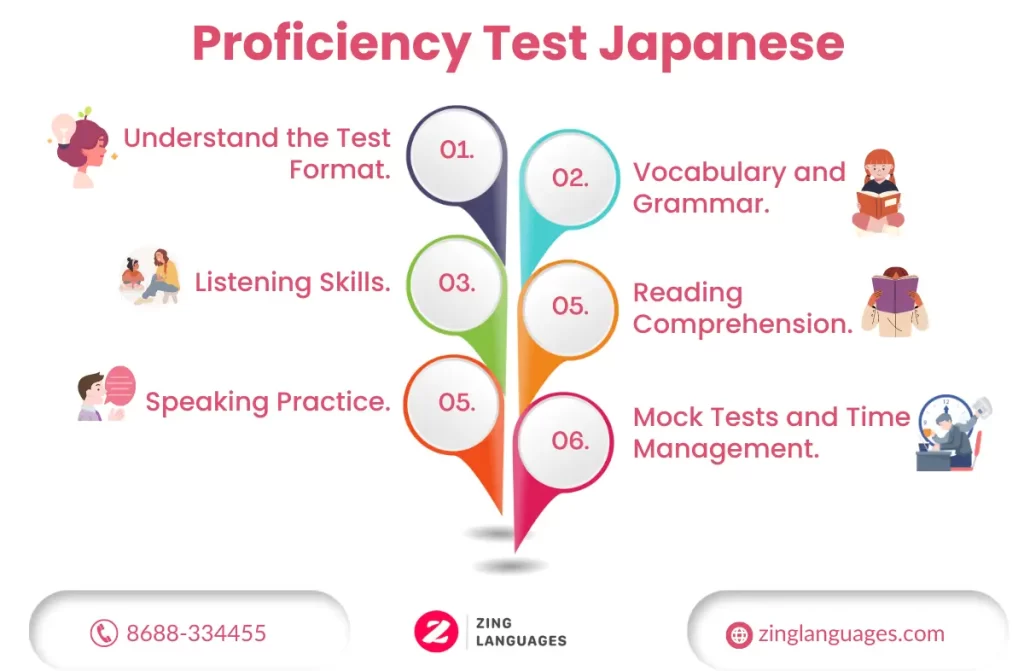The Proficiency Test Japanese, or JLPT (Japanese Language Proficiency Test), stands as a pinnacle of achievement for those seeking to master the Japanese language proficiency level. Whether driven by academic, professional, or personal aspirations, navigating this test requires a strategic approach that encompasses preparation, practice, and perseverance.
This article aims to provide an in-depth exploration of the strategies that can propel you towards excellence in the Proficiency Test Japanese, empowering you to unlock the doors of effective communication and cultural understanding.

Understanding the Japanese Test Structure
First and foremost, a thorough understanding of the test’s structure is paramount. The Proficiency test Japanese consists of five levels, from N5 (the basic level) to N1 (the advanced level). Each Japanese language proficiency level assesses different language skills, encompassing reading, listening, writing, and sometimes speaking.
Delving into the intricacies of each level equips you with insights into the number of sections, types of questions, and time allocated for each section, enabling you to strategize your exam approach effectively.
Setting Clear Japanese language proficiency level
Setting well-defined goals forms the cornerstone of a successful JLPT journey. Ask yourself why you’re pursuing this endeavor. Is it to gain admission to a Japanese university? Enhance your career prospects? The clarity of your objectives guides your study plan.
Whether you’re striving for a specific JLPT level or aiming to bolster your language skills for a particular purpose, these goals serve as your north star throughout the preparation process.
Check Out Japanese NAT Exam.
Creating a Proficiency Test Japanese Study Schedule
The path to excellence is paved with consistent effort. Designing a comprehensive study schedule that covers all aspects of the test is pivotal. Dedicate focused time to each language skill, ensuring a balanced approach to learning.
Allocate periods for daily practice, encompassing reading passages, listening to dialogues, honing writing skills, and, if the level demands, engaging in speaking exercises. Break down your study plan into manageable segments, and include buffer time for revision and full-length mock tests.
Utilizing Authentic Japanese Test Resources
Immerse yourself in authentic resources to cultivate an intuitive grasp of the language. Seek out Japanese news articles, podcasts, TV shows, movies, and literature. Exposure to real-world content not only sharpens your language comprehension but also introduces you to diverse vocabulary, idiomatic expressions, and cultural nuances.
This exposure is particularly invaluable for the reading and listening sections, where contextual understanding is paramount.
Practice Regularly for the Japanese proficiency level
Practice is the bridge between learning and mastery. Solve past JLPT papers and engage in mock tests under timed conditions. Regular practice cultivates familiarity with the question formats, hones your analytical skills, and enhances your ability to navigate the test within the stipulated time.
Each practice session is an opportunity to refine your approach, whether it’s deciphering complex reading passages or catching nuanced details in spoken dialogues.
Focusing on Weaknesses for the Proficiency test Japanese
Identifying and addressing your weaknesses is a testament to your commitment to improvement. If listening comprehension poses a challenge, dedicate focused time to daily listening exercises. Incorporate subtitled videos, podcasts, and audio materials to enhance your auditory skills.
Tailoring your study plan to target your weaknesses results in a well-rounded skill set, a vital asset in the diverse landscape of the JLPT.
Learning Vocabulary and Kanji Systematically for the Proficiency Test
Vocabulary and kanji, the building blocks of language, warrant systematic attention. Curate vocabulary lists specific to your JLPT level and learn them diligently. Employ mnemonic techniques, flashcards, and spaced repetition apps to reinforce memory retention.
Additionally, kanji, while seemingly daunting, can be mastered incrementally. Dedicate time each day to learning and reviewing kanji characters, gradually expanding your reading and writing capabilities.
Simulating Proficiency Test Conditions
The simulated environment mirrors the real-world experience. As the exam date draws near, replicate test conditions during your practice sessions. Time yourself rigorously, adhere to the question formats, and mimic the ambiance of the test center.
By exposing yourself to simulated pressure, you acclimate to the pacing and mental demands of the actual exam, thus mitigating potential test-day jitters.
Regular Review for the Proficiency Test
Consistent review is the key to solidifying your foundation. Allocate weekly intervals for revisiting previously learned material, whether it’s vocabulary, grammar structures, or kanji characters. Regular review ensures that the information remains accessible, reducing the need for last-minute cramming and fostering a gradual, sustainable learning curve.
Staying Calm and Confident on Test Day
As the culmination of your dedicated preparation, the test day demands a composed demeanor. Trust in your efforts and capabilities. Read instructions and questions attentively, manage your time judiciously, and approach each section with confidence. Remember that every step of your journey has equipped you with the tools to navigate this challenge successfully.
Benefits of Proficiency Test Japanese
Proficiency tests Japanese, such as the JLPT (Japanese Language Proficiency Test), offer several benefits. These tests provide an internationally recognized measure of your Japanese language skills, making them valuable for employment, education, or visa applications in Japan.
Achieving higher levels can enhance your career opportunities, as many employers value language proficiency. Additionally, passing these tests demonstrates your dedication to language learning, and it’s a satisfying way to track your progress and set language learning goals.
Conclusion
The Proficiency test Japanese, with its multidimensional evaluation of language skills, necessitates a holistic and strategic approach. As you embark on this transformative journey, celebrate each milestone, recognize your progress, and embrace the profound impact of your commitment to becoming proficient in the Japanese language proficiency level.
Through these well-crafted strategies, you’re poised to excel in the Japanese Proficiency Test and unlock a world of linguistic prowess and cultural enrichment.
Check out Prefectures of Japan.
